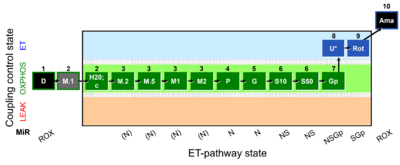| Step
|
State
|
Pathway
|
Q-junction
|
Comment - Events (E) and Marks (M)
|
| 1D
|
ROX
|
|
|
1D
- ADP is added to stimulate the consumption of endogenous fuel-substrates.
|
| 2M.1
|
|
|
|
1D;2M.1
- Low concentration of malate, typically 0.1 mM, does not saturate the N-pathway; but saturates the F-pathway.
- Malate kinetics in the presence of saturating [ADP] allows the evaluation of malate anaplerotic pathways.
|
| 2H2O
|
|
|
|
1D;2M.1;2H2O
- Titration of carrier (H2O) as a control, to be compared with protocols with titration of acylcarnitines to assess fatty acid oxidation-linked respiration.
|
| 3c
|
|
|
|
1D;2M.1;2H2O;2c
- OXPHOS capacity P (with saturating [ADP]), active OXPHOS state.
- Addition of cytochrome c yields a test for integrity of the mtOM (cytochrome c control efficiency). Stimulation by added cytochrome c would indicate an injury of the mtOM and limitation of respiration in the preceding state without added c due to loss of cytochrome c. Typically, cytochrome c is added immediately after the earliest ADP-activation step (OXPHOS capacity P with saturating [ADP]).
|
| 3M.2
|
|
|
|
1D;2M.1;2H2O;2c;3M.2
- Malate kinetics in the presence of saturating [ADP] allows the evaluation of malate anaplerotic pathways.
- OXPHOS capacity P (with saturating [ADP]), active OXPHOS state.
|
| 3M.5
|
|
|
|
1D;2M.1;2H2O;2c;3M.2;3M.5
- Malate kinetics in the presence of saturating [ADP] allows the evaluation of malate anaplerotic pathways.
- OXPHOS capacity P (with saturating [ADP]), active OXPHOS state.
|
| 3M1
|
|
|
|
1D;2M.1;2H2O;2c;3M.2;3M.5;3M1
- Malate kinetics in the presence of saturating [ADP] allows the evaluation of malate anaplerotic pathways.
- OXPHOS capacity P (with saturating [ADP]), active OXPHOS state.
|
| 3M2
|
|
|
|
1D;2M.1;2H2O;2c;3M.2;3M.5;3M1;3M2
- Malate kinetics in the presence of saturating [ADP] allows the evaluation of malate anaplerotic pathways.
- High concentration of malate, typically 2 mM, saturates the N-pathway.
- OXPHOS capacity P (with saturating [ADP]), active OXPHOS state.
|
| 4P
|
PMP
|
N
|
CI
|
1D;2M.1;2H2O;2c;3M.2;3M.5;3M1;3M2;4P
|
| 5G
|
PGMP
|
N
|
CI
|
1D;2M.1;2H2O;2c;3M.2;3M.5;3M1;3M2;4P;5G
|
| 6S10
|
PGMSP
|
NS
|
CI&II
|
1D;2M.1;2H2O;2c;3M.2;3M.5;3M1;3M2;4P;5G;6S10
- Respiratory stimulation by simultaneous action of type N substrates & succinate, with convergent electron flow in the NS-pathway for reconstitution of TCA cycle function.
- OXPHOS capacity P (with saturating [ADP]), active OXPHOS state.
|
| 6S50
|
PGMSP
|
NS
|
CI&II
|
1D;2M.1;2H2O;2c;3M.2;3M.5;3M1;3M2;4P;5G;6S10;6S50
- Respiratory stimulation by simultaneous action of type N substrates & succinate, with convergent electron flow in the NS-pathway for reconstitution of TCA cycle function.
- OXPHOS capacity P (with saturating [ADP]), active OXPHOS state.
|
| 7Gp
|
PGMSGpP
|
NSGp
|
CI&II&GpDH
|
1D;2M.1;2H2O;2c;3M.2;3M.5;3M1;3M2;4P;5G;6S10;6S50;7Gp
|
| 8U
|
PGMSGpE
|
NSGp
|
CI&II&GpDH
|
1D;2M.1;2H2O;2c;3M.2;3M.5;3M1;3M2;4P;5G;6S10;6S50;7Gp;8U
|
| 9Rot
|
SGpE
|
SGp
|
CII&GpDH
|
1D;2M.1;2H2O;2c;3M.2;3M.5;3M1;3M2;4P;5G;6S10;6S50;7Gp;8U;9Rot
- Respiratory stimulation by action of succinate and glycerophosphate, Gp, with convergent electron flow in the SGp-pathway (CII&GpDH-linked pathway to the Q-junction).
- Noncoupled electron transfer state, ET state, with ET capacity E.
|
| 10Ama
|
ROX
|
|
|
1D;2M.1;2H2O;2c;3M.2;3M.5;3M1;3M2;4P;5G;6S10;6S50;7Gp;8U;9Rot;10Ama
- Rox is the residual oxygen consumption in the ROX state, due to oxidative side reactions, estimated after addition of antimycin A (inhibitor of CIII). Rox is subtracted from oxygen flux as a baseline for all respiratory states, to obtain mitochondrial respiration (mt).
|

